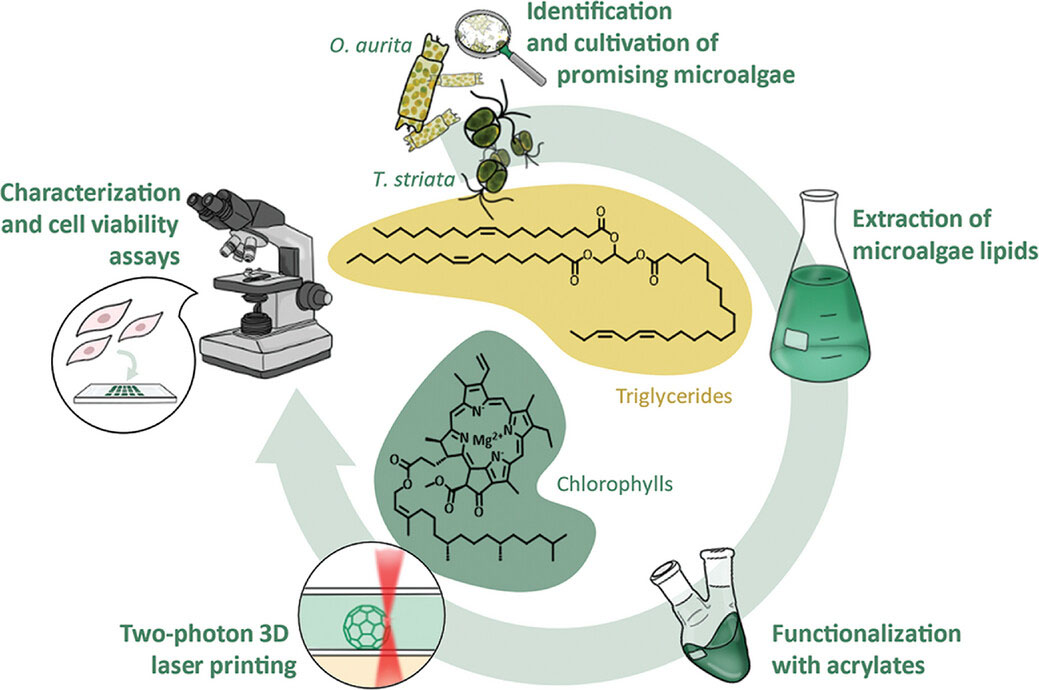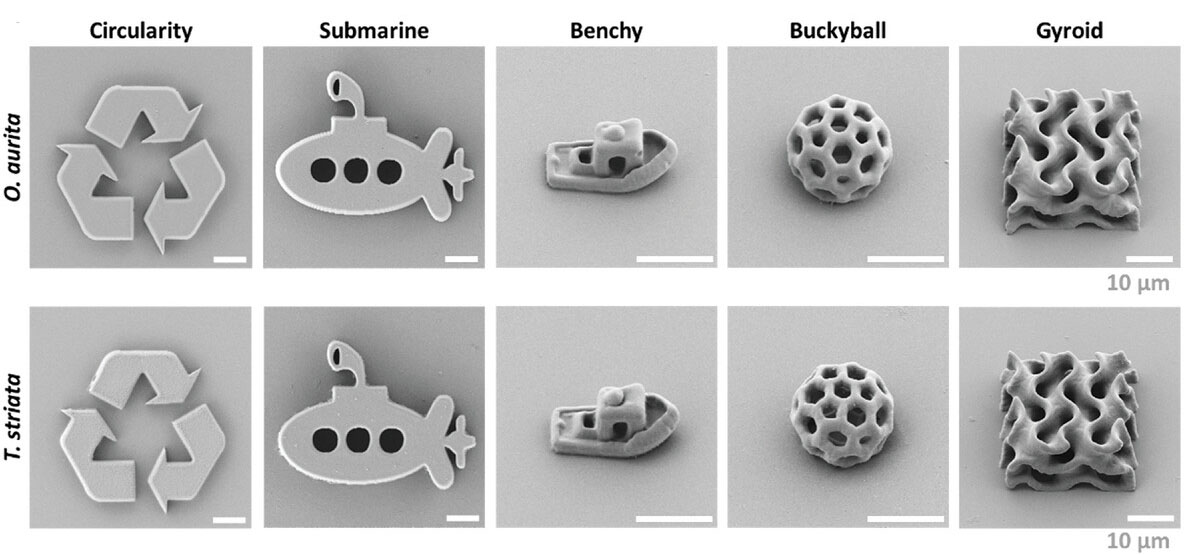| Jul 02, 2024 | |
Green printing revolution with microalgae for biocompatible 3D structures |
|
| (Nanowerk Spotlight) The development of sustainable and biocompatible materials has become increasingly important in scientific research, driven by growing environmental concerns and the need for advanced biomedical applications. This push towards more eco-friendly and biologically compatible materials has been particularly evident in the field of additive manufacturing, where traditional petrochemical-based resources have long dominated. While various renewable sources have been explored, including plant-based oils and agricultural waste products, many challenges have persisted in developing materials that are both eco-friendly and suitable for advanced manufacturing techniques. | |
| The field of additive manufacturing, particularly 3D printing, has revolutionized the production of complex structures across various industries. However, the materials used in these processes have largely remained dependent on non-renewable resources, creating a significant sustainability challenge. This contradiction between the advanced capabilities of 3D printing and its reliance on unsustainable materials has prompted researchers to investigate alternative feedstocks that can meet the stringent requirements of high-resolution 3D printing while also addressing environmental concerns. | |
| Microalgae have emerged as a promising candidate in this search for sustainable resources. These microscopic organisms possess several advantageous characteristics, including rapid growth rates, high biomass productivity, and the ability to fix atmospheric carbon dioxide. Moreover, microalgae can be cultivated in various environments, including non-arable land and wastewater, without competing with food production. Despite these potential benefits, harnessing microalgae for advanced manufacturing applications has remained largely unexplored. | |
| A significant breakthrough in this area has now been achieved by a team of researchers who have successfully developed a method to use microalgae-derived materials for high-resolution 3D printing. This innovative approach, detailed in a recent paper in Advanced Materials ("Printing Green: Microalgae-Based Materials for 3D Printing with Light"), combines the sustainable attributes of microalgae with the precision of two-photon laser printing technology. | |
 |
|
| Overview of the approach established in this work. Two microalgae, namely Odontella aurita (O. aurita) and Tetraselmis striata (T. striata), have been selected and cultivated. The extracts obtained from these microalgae (mainly triglycerides with some chlorophylls) have been functionalized with photopolymerizable groups and used as printable materials for two-photon 3D laser printing. Furthermore, the 3D printed microstructures are afterwards characterized, and their biocompatibility is studied via cell viability assays. (Image: Reproduced with permission by Wiley-VCH Verlag) | |
| Perhaps one of the most significant findings of this research was the discovery that the chlorophyll derivatives naturally present in the microalgae extracts could serve as effective photoinitiators. This eliminates the need for additional, potentially toxic photoinitiating agents commonly used in conventional 3D printing formulations. The concentration of these pigments was estimated to be around 0.4 wt% in the ink, which proved sufficient to initiate the polymerization process during printing. This use of natural, bio-derived photoinitiators represents a major step towards fully sustainable and biocompatible 3D printing materials. | |
| The research team identified two specific microalgae strains, Odontella aurita and Tetraselmis striata, as suitable candidates for their study. These strains were selected based on their high lipid content, particularly triglycerides, and their rapid growth rates. The researchers developed an optimized extraction process to isolate the lipids from the microalgae biomass, focusing on obtaining triglycerides with a high degree of unsaturation. | |
| A key innovation in this work was the chemical functionalization of the extracted triglycerides with acrylate groups. This modification was crucial as it transformed the microalgae-derived materials into photoreactive substances suitable for two-photon 3D laser printing. The researchers adapted a solvent-free, one-step approach to introduce acrylate moieties to the triglyceride molecules. This process resulted in O. aurita-based inks with an average of 2.3 acrylate groups per molecule and T. striata-based inks with 2.8 acrylate groups per molecule. These functionalized materials could then be directly used as printable inks without the need for additional components. | |
| The team conducted extensive studies to determine the optimal printing parameters for these novel microalgae-based inks. They successfully demonstrated the ability to fabricate intricate 3D microstructures with sub-micron resolution, including complex geometries with overhanging features. The printed structures exhibited smooth surfaces and well-defined features, showcasing the high quality achievable with these sustainable materials. | |
 |
|
| SEM images of 3D microstructures printed using O. aurita-based and T. striata-based inks demonstrating the efficiency of the microalgae-based systems. In the case of O. aurita-based inks, a laser power of 25 mW and a scan speed of 12 000 µm s−1 were chosen for filigree structures such as the Benchy, the buckyball and the gyroid geometry. For bulky structures, such as the submarine and the circularity symbol, the scan speed was increased to 14 000 – 16 000 µm s−1. For T. striata-based inks, laser powers between 15 and 20 mW at a scanning speed of 18 000 µm s−1 performed best for bulky structures, whereas filigree structures were preferably printed using 20 mW and 12 000 – 14 000 µm s−1. Scale bar = 10 µm. (Image: Reproduced with permission by Wiley-VCH Verlag) | |
| To evaluate the potential of these microalgae-derived materials for biomedical applications, the researchers performed cell viability assays. They cultured rat embryonic fibroblasts on 3D printed scaffolds and observed that the cells adhered well to the structures and remained viable. This finding indicates the biocompatibility of the printed materials, opening up possibilities for their use in tissue engineering and other biomedical fields. | |
| The team also conducted nanoindentation tests to characterize the mechanical properties of the printed structures. The results revealed distinct properties for materials derived from different microalgae strains. Structures printed with O. aurita inks exhibited a reduced elastic modulus of 108.7 ± 7.5 MPa and a hardness of 3.2 ± 0.1 MPa. In contrast, the 3D microstructures printed using T. striata ink showed higher values, with a modulus of 786.3 ± 51.6 MPa and a hardness of 31.5 ± 1.5 MPa. These findings suggest that the choice of microalgae strain can significantly influence the mechanical characteristics of the printed structures, offering the potential to tailor material properties for specific applications. | |
| This research represents a significant step forward in the development of sustainable and biocompatible materials for advanced manufacturing. By harnessing the natural properties of microalgae, the researchers have created a novel class of printable materials that address several longstanding challenges in the field. The ability to use microalgae-derived triglycerides as the primary component of the printing ink, coupled with the utilization of chlorophyll derivatives as natural photoinitiators, offers a fully bio-based solution that eliminates the need for petrochemical-derived additives. | |
| The implications of this work extend beyond the realm of 3D printing. The successful demonstration of high-resolution fabrication with these microalgae-based materials opens up new possibilities for creating complex, biocompatible structures for tissue engineering, drug delivery systems, and other biomedical applications. Moreover, the sustainable nature of microalgae cultivation and the carbon-fixing properties of these organisms contribute to the overall environmental benefits of this approach. | |
| While this research marks a significant advancement, further work will be necessary to fully realize the potential of microalgae-derived materials in industrial applications. Scaling up the production process, optimizing the extraction and functionalization techniques, and expanding the range of printable structures are areas that warrant continued investigation. Additionally, exploring a wider variety of microalgae strains could lead to the development of materials with diverse properties tailored for specific applications. | |
 By
Michael
Berger
– Michael is author of three books by the Royal Society of Chemistry:
Nano-Society: Pushing the Boundaries of Technology,
Nanotechnology: The Future is Tiny, and
Nanoengineering: The Skills and Tools Making Technology Invisible
Copyright ©
Nanowerk LLC
By
Michael
Berger
– Michael is author of three books by the Royal Society of Chemistry:
Nano-Society: Pushing the Boundaries of Technology,
Nanotechnology: The Future is Tiny, and
Nanoengineering: The Skills and Tools Making Technology Invisible
Copyright ©
Nanowerk LLC
|
|
|
Become a Spotlight guest author! Join our large and growing group of guest contributors. Have you just published a scientific paper or have other exciting developments to share with the nanotechnology community? Here is how to publish on nanowerk.com. |
|
